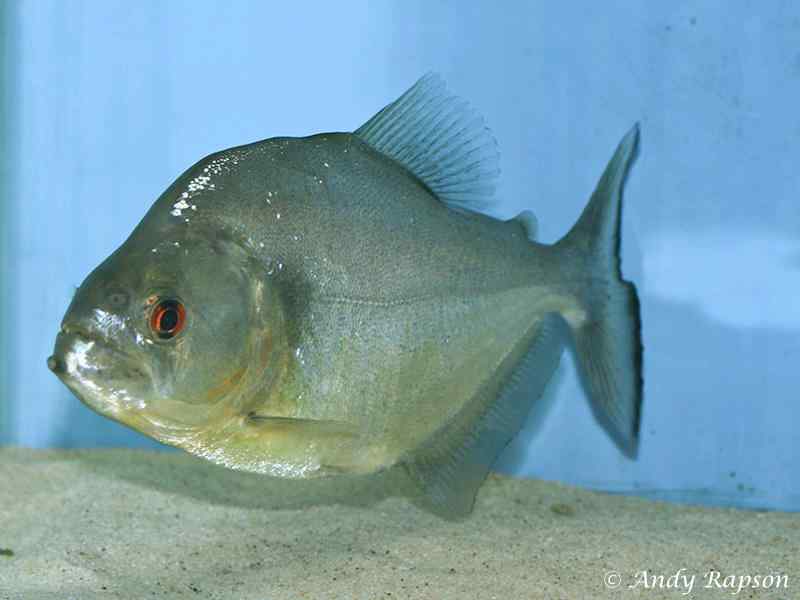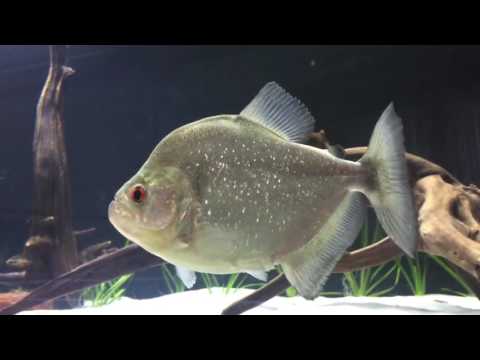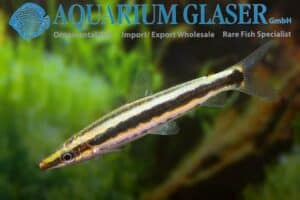Serrasalmus rhombeus – Red Eye Piranha
Serrasalmus rhombeus was first described by Linnaeus in 1766. Their common name is Red Eye Piranha, although you will also find the following names: White Piranha, Black Piranha, Pirambeba, Xingu Rhom, Diamond Rhom, Marbled Rhom etc.
Description
The Red Eye Piranha can reach a total length of at least 45 centimeters. (18″), according to South American locals even as much as 55 centimeters (22″), and possibly even larger. These claims however still have to be substanciated.
Relative to many other species of piranha, there is a relatively large number of large specimens (30 centimeters and over) in private possession, suggesting that this widespread species in the wild can indeed reach considerable size. True giants, above about 40-45 centimeters, however, are again very rare. This species is known for its particularly slow growth rate, and specimens over 30 centimeters are probably at least a decade old.

Body Characteristics
It is very difficult to give a clear description of this species, as it occurs throughout tropical South America. Differences in water chemistry and currents, diet, the natural environment and so on, all influence the appearance of these fish by allowing them to adapt to specific conditions. Said differences result in a wide variety of local variants, with great differences in color, patterns and shape (for this reason many experts also talk about the Serrasalmus rhombeus “complex”, rather than about one species).
In addition to these differences, this species undergoes a number of different stages during its life, during which its color, pattern and shape change quite a bit. In general, young fish have a pointed snout, are silver in color and covered with small black dots (like many piranha species). The eyes are silvery in color and slowly turn deep red when the fish has reached a length of at least 10-12 centimeters, often later. As the fish ages, the profile changes: the fish becomes stockier and higher built.
Some variants have a particularly high back (“High-back” variant), which gives the fish a very impressive appearance. The ground color becomes darker, from gray to pitch black (“Jet Black” rhombeus). Particularly old fish can become lighter in color again, sometimes grayish white, which makes it possible that this species also has the name “White Piranha” in addition to “Black Piranha”. Some adults have iridescent silver scales on the flanks (“Diamond” rhombeus). The same applies to red coloration of gill covers, abdomen and lower jaw: some local variants are quite colorful, while others are rather inconspicuously colored.
The fins are colorless to black, sometimes yellow to red (depending on variety and age), the caudal fin colorless to white, with a gray to black base and tip. Distribution area
Aberrant/unique Appearances:
– Red eyes.
– Never a white/colorless band (hyaline edge) at the end of the caudal fin.
Compatible Species
None: Even conspecifics are not tolerated by this solitary species.
Diet
This species is generally not particularly picky: live fish*, fish fillets and smelt, shrimps, mussels, worms are generally accepted without any problems: in some cases even dry food is eaten.
* When feeding live fish, a number of things should be considered: First, all fish can introduce diseases and/or parasites into the aquarium, including goldfish, windes and other commonly used cold water fish as well as tropical fish. It is therefore also advisable to keep food fish in a quarantine aquarium for a week or 2, in order to ‘flush out’ the sick and weakened specimens. In addition, it should be taken into account that goldfish and close relatives are not particularly nutritious. A diet that usually consists of live fish is therefore not recommended. All the more because goldfish and other Cyprinidae (carp-like) contain hormones – so-called “Thiaminase / Vitamin B1 inhibitors” – that paralyze the production of certain growth-stimulating substances in predatory fish. A very one-sided goldfish diet can therefore lead to growth and development disorders!
It may take a while for the fish to accept prepared food: if this is the case, make sure the fish is well fed with live food and then introduce a fasting period of a week to 12 days. During this period, provide the desired prepared food while the lighting is dimmed or turned off. If it doesn’t work the first time, supplement with live food and try again. Piranhas can go without food for a number of weeks without any problems, so the fish is not in any danger during this “cure” (with the exception of specimens smaller than about 8 centimeters!).

The Aquarium
This species grows very slowly, and for that reason they do well for a long time in a smaller aquarium: young and half-grown specimens do well in an aquarium of 80-100 centimeters. However, once they have reached a length of about 20-25 centimeters, they should be moved to a larger tank: an aquarium of at least 150 centimeters long and 50 centimeters deep is completely sufficient in most cases.
In terms of aquarium setup, this species is undemanding: as long as a few hiding places are present (in the form of plants, rocks, vegetation or a combination thereof), and a powerful powerhead (adapted to the size of the fish, of course) provides current, the fish will have a great time.
Because all specimens in captivity are wild-caught, it may take some time for them to feel at home in their new environment, ranging from a few days to many months. For this reason, hiding places are very important, especially in the initial phase of acclimatization, so that the fish can retreat if it does not feel comfortable. As time goes by, the fish will feel more at home and use the hiding places provided less and less often.
The temperature of the water may be between 24 and 30 degrees Celsius with a pH of 5.5 to 7.5.
Comments
This large, very powerful species is considered harmless in the wild, but can nevertheless inflict terrible wounds. It is said that a fully grown specimen can easily bite off a human hand at the wrist in two or three bites, and given the enormous jaws and size of adults, this certainly does not seem exaggerated. No matter how long you have owned the fish, always approach it with the utmost respect!
Video
Author
Jonas Hansel – Piranha-info.com (original website no longer available)
Copyright images
Screenshots from video
Andy Rapson – Fishtanksandponds.co.uk (original website no longer online)










